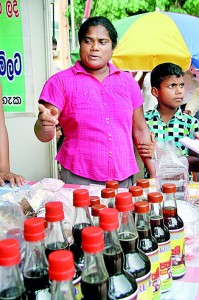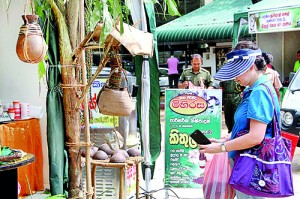All that’s sweet and more with Kitul
With the cry of the Koha and all the advertising over the media it’s evident that the Avurudu season is upon us. From the songs, the aroma of sweetmeats in the air and all the festivities, the traditional sports and other revelry so many elements go into the festival everyone looks forward to.
Speaking of sweetmeats associated with Avurudu, an ingredient that cannot be ignored is Treacle or peni. Anyone familiar with sweetmeats will know that the best taste can be achieved with the addition of Kithul treacle, considered the best among many other types like Coconut or Palmyrah.

A taste of treacle: A stall at the fair
To boost sales and give greater exposure to Kithul producers, the Traditional Industries and Small Enterprise Development Ministry has been holding an annual exhibition and trade fair, Kithulaka Waruna for the past five years. This year the exhibition at the Sudharshi Cultural Institute in Colombo was declared open by Economic Development Minister Basil Rajapaksa on April 4. Today is the last day of the exhibition.
The main aim of the exhibition is to promote Kithul products among the public and to uplift the living standards of Kithul tappers. It also aims to develop a sustainable relationship with exporters and producers and to boost foreign market opportunities. The exhibition showcased about 50 stalls presenting products made from different parts of the Kithul tree such as treacle, jaggery (Hakuru), flour (Kithul Piti) and handicrafts made out of the wood and even the dried flower strands (Kithul Rena) of the tree. Certificates and awards were presented to producers and manufacturers who met high standards.
Both foreign and local customers were seen in their numbers in the open area opposite the BMICH as producers from Kalutara, Wadduwa, Ratnapura, Kegalle, Kandy and Nuwara Eliya showcased their products.
“We have been taking part in this exhibition since it started,” said Sunitha Chandrakanthi, a producer from the Kalawana area in Molkawa who makes many items such as treacle, flour, jaggery, different types of sweetmeats as well as selling a warm glass of Kithul Porridge (Kenda). Her family business has also won both the first prizes for best jaggery and the best food and drink last year at this exhibition.
Piyal Pradeep learnt the trade from his father who in turn had learnt it from his father, the family being in this trade for three generations. Living in Baduraliya, a town close to Sinharaja forest, obtaining the raw sap is not difficult. “We buy directly from the permitted tappers who tap the trees in the forest. We also sell our products to exporters,” Pradeep says.
Another use of the Kithul tree is its wood, dark in colour with a white grain, heavy and hardy enough to last for centuries. Although initially used for door and window frames for its durability, creative entrepreneurs have now moved on to making furniture as well as different decorations with the wood. Sunil Wijesinghe has been using the wood for his products for the past two years. Buying the tree from nearby villagers, he says that, years ago, they were difficult to source as elephants loved to eat them. But now with elephants less frequently visiting the villagers, wood is rotting away which gave him the idea to use it for his work. “Since this is a new idea there’s a good demand for the products,” he says. He makes wall hangers and clocks as well as other decorative items like lamps and floor tiles from the Kithul wood.
Less optimistic was P.H. Sugath Wijeratne who makes small ornaments and accessories from the Kithul wood. “Although those days we

Public interest in the fair is high. Pix by Indika Handuwala
had many trees in the villages now we have to buy the wood we need for our products,” says Wijeratne who has five workers under him and undertakes orders as well. He has been in the business since ‘94.
The Kithul flower has long strands reaching five feet in length at times and has always been a poetic image for the long cascading hair of women in the Sinhala language. D.V. Nimal Karunaratne boils and seasons the strands of the Kithul flower to make lamp shades, vases, mats and baskets. He has been working with the Kithul flower for 15 years he says, and has won the award for the most creative producer on several occasions in the Kithulaka Waruna exhibition.
“I think it’s a great idea to bring these rural producers to Colombo and hold this exhibition. Especially since during this season we need good treacle to make all the food and we have no option but to go to supermarkets to buy the treacle and jaggery and even then the quality is not so good,” said Tamara Jayawardene, who was visiting the exhibition for the first time.
“We meet so many new customers who sometime call and come to our village later looking for us to buy our products. This is a very profitable opportunity for us,” said a producer from Pelawatte, Mathugama, Wijemuni Piyaratne who has been in the field for the past 12 years.
The government declared the first week of April, as the Kithul Promotion and Consumer Week. District level awareness, Kithul sapling distribution and promotion of Kithul products were done during the week.



